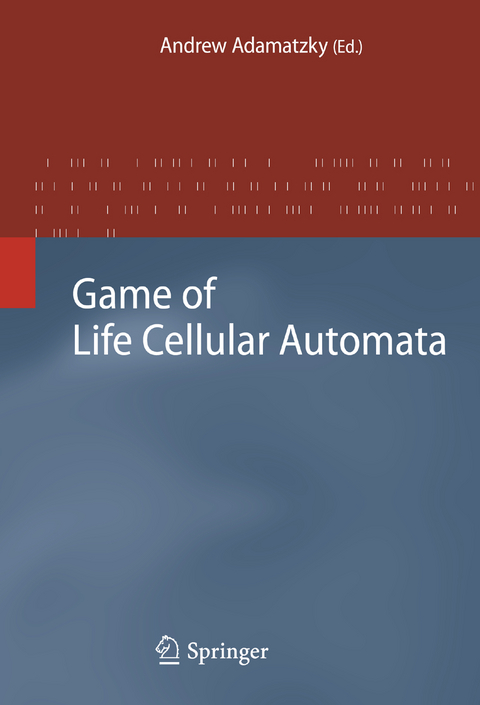
Game of Life Cellular Automata
Springer London Ltd (Verlag)
978-1-4471-6154-7 (ISBN)
In the late 1960s British mathematician John Conway invented a virtual mathematical machine that operates on a two-dimensional array of square cell. Each cell takes two states, live and dead. The cells’ states are updated simultaneously and in discrete time. A dead cell comes to life if it has exactly three live neighbours. A live cell remains alive if two or three of its neighbours are alive, otherwise the cell dies. Conway’s Game of Life became the most programmed solitary game and the most known cellular automaton.
The book brings together results of forty years of study into computational, mathematical, physical and engineering aspects of The Game of Life cellular automata. Selected topics include phenomenology and statistical behaviour; space-time dynamics on Penrose tilling and hyperbolic spaces; generation of music; algebraic properties; modelling of financial markets; semi-quantum extensions; predicting emergence; dual-graph based analysis; fuzzy, limit behaviour and threshold scaling; evolving cell-state transition rules; localization dynamics in quasi-chemical analogues of GoL; self-organisation towards criticality; asynochrous implementations.
The volume is unique because it gives a comprehensive presentation of the theoretical and experimental foundations, cutting-edge computation techniques and mathematical analysis of the fabulously complex, self-organized and emergent phenomena defined by incredibly simple rules.
Andrew Adamatzky is a Professor in Unconventional Computing in the Department of Computer Science, and a member of Bristol Robotics Lab. He does research in reaction-diffusion computing, cellular automata, physarum computing, massive parallel computation, applied mathematics, collective intelligence and robotics.
to Cellular Automata and Conway’s Game of Life.- Historical.- Conway’s Game of Life: Early Personal Recollections.- Conway’s Life.- Life’s Still Lifes.- A Zoo of Life Forms.- Classical topics.- Growth and Decay in Life-Like Cellular Automata.- The B36/S125 “2x2” Life-Like Cellular Automaton.- Object Synthesis in Conway’s Game of Life and Other Cellular Automata.- Gliders and Glider Guns Discovery in Cellular Automata.- Constraint Programming to Solve Maximal Density Still Life.- Asynchronous, Continuous and Memory-Enriched Automata.- Larger than Life’s Extremes: Rigorous Results for Simplified Rules and Speculation on the Phase Boundaries.- RealLife.- Variations on the Game of Life.- Does Life Resist Asynchrony?.- LIFE with Short-Term Memory.- Localization Dynamics in a Binary Two-Dimensional Cellular Automaton: The Diffusion Rule.- Non-Orthogonal Lattices.- The Game of Life in Non-square Environments.- The Game of Life Rules on Penrose Tilings: Still Life and Oscillators.- A Spherical XOR Gate Implemented in the Game of Life.- Complexity.- Emergent Complexity in Conway’s Game of Life.- Macroscopic Spatial Complexity of the Game of Life Cellular Automaton: A Simple Data Analysis.- Physics.- The Enlightened Game of Life.- Towards a Quantum Game of Life.- Music.- Game of Life Music.- Computation.- Universal Computation and Construction in GoL Cellular Automata.- A Simple Universal Turing Machine for the Game of Life Turing Machine.- Computation with Competing Patterns in Life-Like Automaton.
| Erscheint lt. Verlag | 4.11.2014 |
|---|---|
| Zusatzinfo | XIX, 579 p. |
| Verlagsort | England |
| Sprache | englisch |
| Maße | 155 x 235 mm |
| Themenwelt | Informatik ► Software Entwicklung ► User Interfaces (HCI) |
| Informatik ► Theorie / Studium ► Algorithmen | |
| Informatik ► Theorie / Studium ► Künstliche Intelligenz / Robotik | |
| Mathematik / Informatik ► Mathematik ► Logik / Mengenlehre | |
| ISBN-10 | 1-4471-6154-8 / 1447161548 |
| ISBN-13 | 978-1-4471-6154-7 / 9781447161547 |
| Zustand | Neuware |
| Haben Sie eine Frage zum Produkt? |
aus dem Bereich


